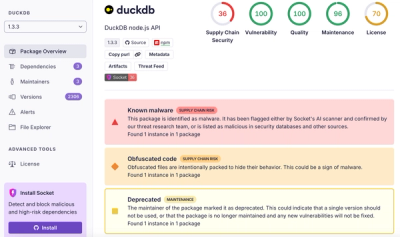
Product
Introducing Tier 1 Reachability: Precision CVE Triage for Enterprise Teams
Socket’s new Tier 1 Reachability filters out up to 80% of irrelevant CVEs, so security teams can focus on the vulnerabilities that matter.
The PyPowSyBl project gives access PowSyBl Java framework to Python developers. This Python integration relies on GraalVM to compile Java code to a native library.
Latest version of the documentation with API reference and many code samples is here.
To contribute to the documentation follow the instructions in the documentation README page.
Notebooks demonstrating PyPowSyBl features can be found in this repository.
PyPowSyBl is released on PyPi for Python 3.9 to 3.13, on Linux, Windows and MacOS.
First, make sure you have an up-to-date version of pip and setuptools:
pip install --upgrade setuptools pip
Then you can install PyPowSyBl using pip:
pip install pypowsybl
First, we have to import pypowsybl:
import pypowsybl as pp
We can create an IEEE 14 buses network and run a load flow computation:
n = pp.network.create_ieee14()
results = pp.loadflow.run_ac(n)
print(results)
[ComponentResult(connected_component_num=0, synchronous_component_num=0, status=CONVERGED, status_text=CONVERGED, iteration_count=3, reference_bus_id='VL1_0', slack_bus_results=[SlackBusResult(id='VL1_0', active_power_mismatch=-0.006730108618313579)], distributed_active_power=0.0)]
We can now get buses data (like any other network elements) as a Pandas dataframe:
buses = n.get_buses()
print(buses)
v_mag v_angle
VL1_0 1.060 0.00
VL2_0 1.045 -4.98
VL3_0 1.010 -12.72
VL4_0 1.019 -10.33
VL5_0 1.020 -8.78
VL6_0 1.070 -14.22
VL7_0 1.062 -13.37
VL8_0 1.090 -13.36
VL9_0 1.056 -14.94
VL10_0 1.051 -15.10
VL11_0 1.057 -14.79
VL12_0 1.055 -15.07
VL13_0 1.050 -15.16
VL14_0 1.036 -16.04
This is just a quick appetizer of PyPowSyBl features. PyPowsybl provides a lot more features: security analysis, sensitivity analysis, handling of multiple file formats (including CGMES), substation and network diagrams generation, ... For more details and examples, go to the documentation and Jupyter notebooks.
That section is intended for developers who wish to build pypowsybl from the sources in this repository.
Requirements:
To build from sources and install PyPowSyBl package:
git clone https://github.com/powsybl/pypowsybl.git
cd pypowsybl
export JAVA_HOME=<path to GraalVM>
pip install --upgrade setuptools pip
pip install -r requirements.txt
pip install .
While developing, you may find it convenient to use the developer (or editable) mode of installation:
pip install -e .
# or, to build the C extension with debug symbols:
python setup.py build --debug develop --user
Please refer to pip and setuptools documentations for more information.
To run unit tests:
pytest tests
To run static type checking with mypy:
mypy -p pypowsybl
To run linting inspection with pylint:
pylint pypowsybl
FAQs
A PowSyBl Python API
We found that pypowsybl demonstrated a healthy version release cadence and project activity because the last version was released less than a year ago. It has 3 open source maintainers collaborating on the project.
Did you know?

Socket for GitHub automatically highlights issues in each pull request and monitors the health of all your open source dependencies. Discover the contents of your packages and block harmful activity before you install or update your dependencies.

Product
Socket’s new Tier 1 Reachability filters out up to 80% of irrelevant CVEs, so security teams can focus on the vulnerabilities that matter.

Research
/Security News
Ongoing npm supply chain attack spreads to DuckDB: multiple packages compromised with the same wallet-drainer malware.

Security News
The MCP Steering Committee has launched the official MCP Registry in preview, a central hub for discovering and publishing MCP servers.